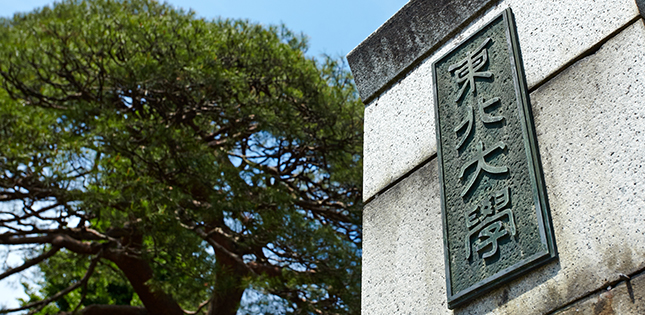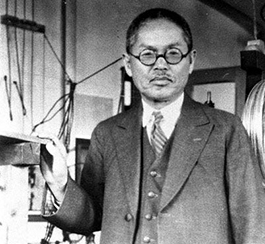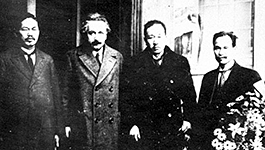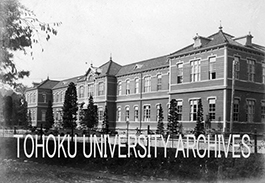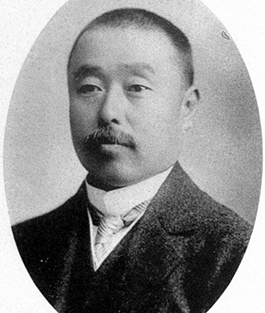A University Built on Castle Grounds
The ancient castle grounds of Sendai's famous feudal war lord Masamune Date, are home to the majority of Tohoku University's facilities. In addition to the five main campuses is the new Aobayama campus on Aobayama mountain surrounded by beautiful fir forests native to the region's hilly terrain.
The primeval forest served as a natural fortress for Sendai castle, which was built in 1602. It was protected under the strict supervision of the Sendai clan. This protection continued under the auspices of the national military following the Meiji Restoration in 1868. When World War 2 ended in 1945, the area was home to a military base of the occupation forces. It remained off limits to civilians for many years.
The Tohoku University Botanical Gardens, was founded for research and education on Aobayama mountain, in 1958. Due to its preservation for 400 years it is now home to flora and fauna of priceless academic value. In 1972, the garden was designated a natural monument, a first for a national university botanical garden. It is one of only three national university botanical gardens in Japan.
Today, Aobayama's 400 year history of natural beauty endures next door to the thriving metropolis of Sendai city, home to more than one million people.
A Global Vision 400 Years Ago
Tohoku University's global origins lie in the very soil in which the university was seeded. Because Tohoku lies outside Tokyo's central corridor, the region has often bypassed the capital and conducted world affairs on its own. This tradition dates back nearly 400 years. In 1613, the head of the Sendai Clan, Masamune Date sent a diplomatic envoy headed by Tsunenaga Hasekura to Spain and the Vatican. They returned with agreements for direct trade with Mexico and the dispatch of Christian missionaries from the Pope.
Like Masamune, Tohoku University continues to reach out to the world in the pursuit of truth. As of 2015, Tohoku University comprised a global network of over 300 overseas universities and research centers.
A Gathering of Great Minds
In preparation for the establishment of the third imperial university, the Ministry of Education entrusted Hantaro Nagaoka, the top scientist at the time, with the task of selecting the first professorial staff. Nagaoka chose so many talented and creative individuals from around the country that it was rumoured that the center of Japan's physics and mathematics research had shifted to Sendai.
In the autumn of 1907, the Ministry of Education sent eight of those professors, among them Kotaro Honda, Riko Majima, Matsusaburo Fujiwara and Shirota Kusakabe, to Europe to study. Spending most of their time in Germany and England, they held many discussions about the new university and acquired books and equipment. Upon their return to Japan, these men played a critical role in the development of Tohoku Imperial University. Continuously presenting new research, they earned global acclaim. This was the origin of the university's culture of pursuing knowledge at the world's leading edge.
Innovative Policies from a First President
In 1888, Masataro Sawayanagi joined the Meiji Government's ministry of Education. he took the initiative to reform Japan's public education system. In 1907, as Vice Minister of Education, Sawayanagi was involved in the founding of Tohoku Imperial University. In 1911, he moved to Sendai to become the university's first president.
Sawayanagi strongly believed that students should be given the skills and knowledge to find work that that would make a positive contribution to society. At the time, these ideas were considered highly innovative. Following Sawayanagi's lead, Tohoku University adopted the principles of 'Open Doors', 'Research First', and 'Practice Oriented Research and Education' .
Sawayanagi believed that rather than merely offering elitist specialized education, the university's main purpose to educate, should not see them discriminate based on class or gender. This 'Open Door' policy laid the foundation for the acceptance of students from technical high schools in 1911, and the first females at a Japanese university in 1913.
The 'Research First' principle called upon scholars to not only pursue highly productive research but to also put their findings to work in the teaching of their students. In addition to this, Tohoku University has nurtured a tradition of "Practice Oriented Research and Education," in which the results of cutting edge research are being put to use for the good of society and the improvement of living standards.
These principles remain very much intact today as we strive to become one the world's great research universities.

